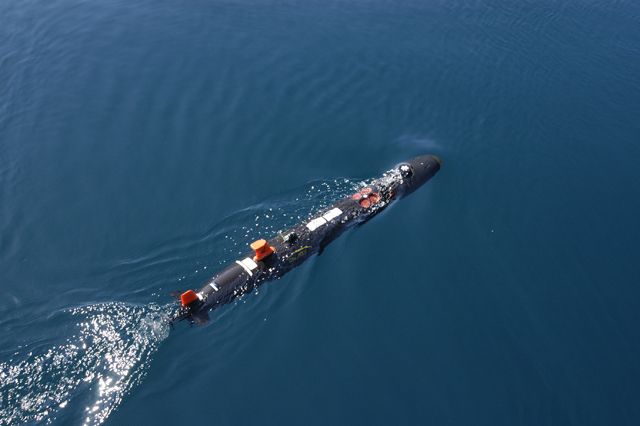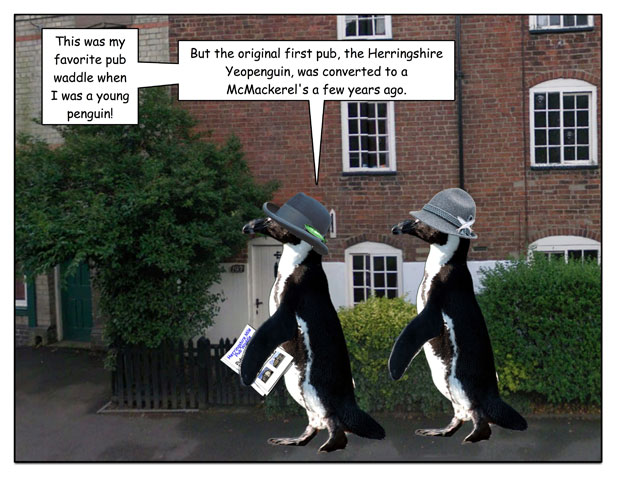
Photo Courtesy: Mark Moline | Above: Photo Credit: Peter Rejcek Adélie penguins near Palmer Station. | Left: Scientists deploy a REMUS AUV over the side of a small boat off the coast of Florida. Mark Moline will employ a similar instrument in Antarctica to track Adélie penguins as they hunt for food during their breeding season to learn about the places they favor. |
Bird watching
Autonomous robot to follow penguins as they hunt for food
By Peter Rejcek, Antarctic Sun Editor
Posted November 19, 2010
Mark Moline

was working on his PhD in the early 1990s when he was last doing research along the Antarctic Peninsula — the first graduate student of the nascent Palmer Long Term Ecological Research (PAL LTER) program

.
Scientists with the PAL LTER were only just getting a handle on the marine ecosystem of the northwestern peninsula region at the time. They knew the sea ice that waxed and waned on the ocean waters with the seasons played a key role, serving as an important habitat for critters from Adélie penguins to shrimplike krill.
What they didn’t know then was that the region was already undergoing remarkable changes. A warmer and moist subantarctic climate was shoving the colder and drier conditions farther south.
Now the researchers understand the northern Antarctic Peninsula is warming faster than just about anywhere on the planet. Average winter temperatures have increased about 6.5 degrees Celsius since the 1950s, rising more than five times faster than the global average.
Deep, warm water is flooding onto the relatively shallow continental shelf due to complex interactions between the ocean and atmosphere. That’s affected the lifecycle of winter sea ice, which on average has dropped by three months per year, meaning it forms later and melts earlier. Year-round sea ice has virtually disappeared.
The sea-ice dependent species have also taken a hit. The most obvious and well-documented is the plight of the Adélies. If current conditions persist, the local colonies will be all but extinct by the end of the decade.
That’s the Antarctic Peninsula today, about 17 years after Moline last visited. Now a professor at California Polytechnic State University

and director of the school’s Center for Coastal Marine Sciences

, Moline will return to the Ice this season to help answer an important question about Adélie ecology in the context of today’s changing climate.
Namely: Why do they forage in the locations that they do?
And the best way to figure that out is to follow the adult penguins while they are busy searching for food for their young chicks during the height of the fledgling period in December and January.
Photo Credit: Peter Rejcek
Adélie penguins near Palmer Station.

Photo Courtesy: Mark Moline
Divers handle the AUV in more temperate waters than what the robot will swim through in Antarctica.
For that job Moline will employ a REMUS autonomous underwater vehicle (AUV) whose suite of sensors will tell scientists about the oceanographic conditions where the penguins hunt, as well as the biomass of potential prey in the area — how much food is available to eat.
“The underwater vehicle matches up almost identically to the birds’ endurance, depth and speed characteristics,” Moline explained. “It does what a penguin does in terms of its foraging journey. It’s an ideal tool for going out and characterizing these birds.”
Moline is collaborating with Bill Fraser

, who heads the seabird component of the PAL LTER program. Members of Fraser’s team spend each austral summer working out of the U.S. Antarctic Program’s

smallest research base, Palmer Station

, tracking and observing the Adélies and other bird populations.
The Palmer Station “birders” use satellite tags to track individual penguins. The researchers have known for some time the Adélies favor various canyons along the continental shelf where the bathymetry, or underwater topography, induces an upwelling of warmer water.
The conditions seem to produce a hotspot of biological activity, offering a reliable and long-term source of food for the penguins.
Fraser said that Moline’s instrument should provide information to test hypotheses about these hotspots and better define the conditions that exist. “These data should also provide some predictive capabilities, by which I mean they should give us some idea about where Adélie colonies may emerge in the southern [Western Antarctic Peninsula] as warming continues,” Fraser said.
The canyons near Palmer Station and similar features down the peninsula have been explored to some degree by a different AUV called a Slocum glider. However, the REMUS vehicle will be able to follow the birds in “real-time” based on location information from the satellite tags.
“That’s the first time that’s been done,” Moline said. “The animals can tell us where they’re going, but the vehicles can tell us why they’re going there.”
Moline and his colleagues have deployed the AUVs around the world in all sorts of environments, logging more than 5,000 kilometers under water on more than 250 missions.

Photo Courtesy: Mark Moline
The REMUS vehicle has logged more than 250 missions.
Their research includes work in the Arctic off Svalbard, Norway, where the intrusion of North Atlantic Ocean water into the region is potentially disrupting the food web. One bird species, the little auk, which superficially resembles a penguin, was found to be diving deeper in the water to find more nutritious prey.
“It’s a similar study but in a different area,” Moline noted.
For the Antarctic study — a one-year field project funded by the National Science Foundation’s

EArly-concept Grants for Exploratory Research (EAGER) program — Moline and technician Ian Robbins will spend about five weeks at Palmer Station. Every couple of days they will release the AUV to hunt with the penguins, as well as to characterize areas where the penguins aren’t going.
“One of the efforts here is to not only characterize the penguins’ habitat, per say, but also do it in the context of this large-scale change that is occurring,” Moline said.
Moline said he hopes the technology will prove its worth on this trial project so that it can be used in the future to track the other animal populations in the region, including the gentoo and chinstrap penguins, subantarctic species that are growing in numbers as the Adélies decline.
“It seems like these tools are prime time for polar regions,” Moline said. “We’ve been trying to push these technologies in the polar regions that are traditionally under sampled from a marine perspective. We’re trying to break some new ground here with some new technology.”
In addition to the collaboration with Fraser’s Polar Oceans Research Group, Moline’s data will be used as part of a NASA

program involving several institutions that links satellite data of changes in the ocean to penguin foraging.
All of this effort will eventually feed into the bigger picture of how climate change is affecting the ecosystem of the Antarctic Peninsula, according to Moline.
“It’s pretty amazing that large-scale changes can occur during one’s career,” he said.
NSF-funded research in this story: Mark Moline, California Polytechnic State University, Award No. 1019838  .
Source
.
Source
























 By Philip Knowling
By Philip Knowling































